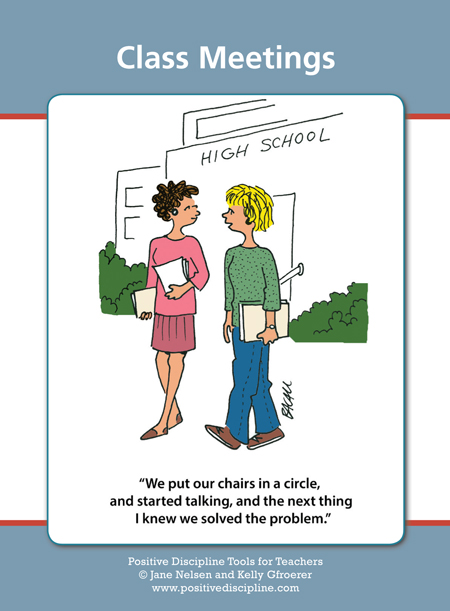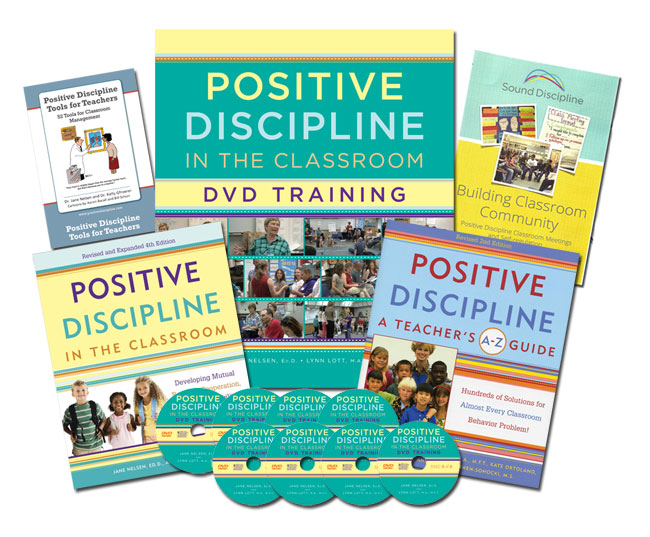by Jane Nelsen, co-author of Positive Discipline in the Classroom
Many teachers use circle time, morning meetings, or what they may call class meetings. Most of these meetings are “teacher generated.” In other words, the teacher decides what should be discussed or follows a program with suggested topics designed to teach children about these topics. Positive Discipline class meetings are designed to be “student generated,” and to “focus on solutions,” meaning that it is the students who put their concerns on an agenda (although teachers can too) and then everyone brainstorms for solutions. Through this format, students learn from the inside out by being involved, instead of from the outside in—lectures or lessons taught by others. The root of education is educaré, which means “to draw forth.” When adults “teach” by “drawing forth,” students feel capable, belonging and significance, and more motivated to follow the solutions they help create.

Positive Discipline Class Meetings provide an opportunity for students to learn valuable social and life skills for good character
- Listening skills
- Brainstorming skills
- Problem-solving skills
- Mutual respect
- The value of cooling off before solving a problem. (Problems are put on the class meeting agenda so a cooling off period takes place before focusing on solutions to the challenge.)
- Concern for others
- Cooperation
- Accountability in a safe environment. (People don’t worry about admitting mistakes when they know they will be supported to find solutions instead of experiencing blame, shame, or pain.)
- How to choose solutions that are respectful to everyone concerned
- Social interest
- That mistakes are wonderful opportunities to learn
Class Meeting Format
- Compliments and appreciations
- Follow up on prior solutions
- Agenda items
a. Share feelings while others listen
b. Discuss without fixing
c. Ask for problem-solving help - Future plans (field trips, parties, projects)
Take time for Training
Students need training before they can be effective in Positive Discipline Class Meetings. Without training they may use the “skills” they are used to: blaming, punishing others, avoiding accountability for fear of receiving punishment. The book, Positive Discipline in Classroom, by Jane Nelsen, Lynn Lott, and H. Stephen Glenn, include activities to help children.
Eight Skills For Effective Class Meetings
- Forming a circle.
- Practicing compliments and appreciations.
- Respecting differences.
- Using respectful communication skills.
- Focusing on solutions.
- Role-playing and brainstorming.
- Using the agenda and class meeting format.
- Understanding and using the mistaken goals.
Guidelines for Effective Class Meetings
- Students sit in a circle, and the teacher sits in the circle at the same level if possible.
- In classes where the students are old enough, students will eventually lead the meetings.
- The teacher (or student in charge) will start the compliments by passing a “talking item” (such as a talking stick or Kush ball) around the circle so every student has an opportunity to give a compliment, pass, or ask for a compliment. It is effective to have Elementary School students use the words, “I would like to compliment ________ for ___________. (When students say, “I like the way _________”, it is more about them that the other person.) Middle and High School students seem to prefer, “I would like to acknowledge _________”, or “I appreciate __________.”
- When students ask to “get” a compliment, they have two or three seconds to choose someone (several students will raise their hands) to give them a compliment. Otherwise it starts looking like a popularity contest.
- The receiver of a compliment will say, “Thank you.”
- The teacher or student in charge will handle the agenda and read off the next item to be discussed.
- After the agenda item is read, the student who placed the problem on the agenda can choose between,
a) sharing feelings while others listen
b) discussion without fixing)
c) asking for problem-solving help. - If the student asks for discussion without fixing, or for problem-solving help, the talking item will be passed around the circle again for students to discuss without fixing, or to brainstorm for solutions. (Short comments are also allowed.)
- The teacher refrains from commenting on the students suggestions (except to make sure the student is giving a suggestion. It may be necessary to say, “How could you turn that into a suggestion?”). When the item reaches the teacher, he or she can make a comment or suggestion—but only then.
- Each suggestion is written in a notebook or on a flip chart.
- In the beginning, the students may suggest things that sound more like punishment than a solution. If this is the case, the teacher or student in charge can request that they go over each suggestion and delete those that are hurtful, not helpful, not respectful, not reasonable, or not practical. This should be done at the end of brainstorming, not during.
- In most cases, the talking item will go around the circle twice to give children an opportunity to make a suggestion they didn’t think of before listening to others. (This doesn’t take as long as some fear.)
- A vote will be taken only if the problem involves the whole class. Otherwise, the student who put the problem on the agenda can choose the suggestion he or she thinks will be most helpful. When two students are involved, each can choose the suggestion that will be most helpful to him or her. (If the suggestions they choose seem incompatible, they can get together and work it out.)
Six Reasons Class Meetings Fail
- Not forming a circle.
- Not having them regularly (3 to 5 times a week in elementary school) to give students a chance to absorb and practice the skills.
- Not allowing time for students to learn the eight skills for class meetings.
- Not passing a talking item around the circle so every child has a chance to speak or pass.
- Not allowing a student to choose the solution he/she thinks would be the most helpful.
- Control and expediency are seen as more important than teaching children life skills.
Click Here to Get the Positive Discipline in the Classroom Training for Your School.


